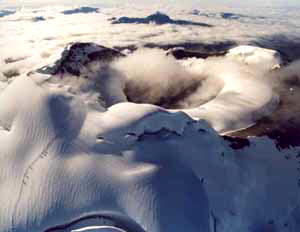 |
Reventador is a 3.600 m high stratovolcano,
about 95 kilometers northeast of Quito, the capital of Ecuador.
El Reventador has a history of explosive
eruptions, lava flows and lahars.
It is well documented that those events were seen as far away
as Quito and that ashes from those events fell on the capital.
The last period of eruptions occurred in the seventies and from
then on till now the volcano entered into a period of lesser
activities. From 1541 it has registered 25 eruptions; the last
one
happened in 1976.
|
click on picture
to the left for larger view
Thursday, January
12th, 2012
IG reported that staff conducting
fieldwork at Reventador during 6-7 January observed constant emissions
of gas-and-
steam rising about 300 m above the crater and drifting WNW. The
emissions originated from a growing lava dome
that was a few tens of meters above the crater rim and almost filled
the base.
November
19th, 2002
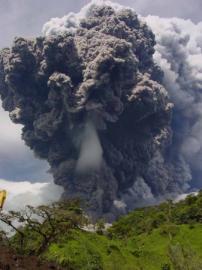 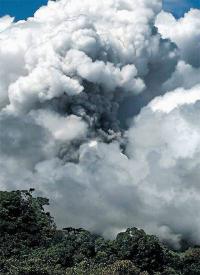
Reventador
on 2002-11-03, and it is still very active 2002-11-18
Click on the left picture
for larger view
© TECHINT and Pavel Calahorrano
- El Comercio
At 09:55 yesterday a steam emission took place spewing water and
ash into the air (photo).
Soon a flow of stones and mud covered the highway Chaco-Nueva Loja
(Lago Agrio).
The report of the Geophysic Institute yesterday noticed that there
is a slow lava flow on
the South flank of the volcano-crater.
Yesterday morning the weather was exceptionally
clear, and there was a beautiful view of the Reventador-volcano.
But it did not last long. After the eruption, the mudflow was even
more damaging than the one of last saturday. However, the Transequatorial
Pipe Line with crude-oil
is still not cut off, and the now very tired workers do hope this
mudflow was the last one.....
As usually when caught by a volcano-eruption destroying
the grasland with ash, many farmers are selling their cattle - and
the buyers are lowing their prices. They know the farmers are forced
to sell, as the ash has made the gras unusable for at least half
a year ahead.
November 17th, 2002
People in the area around Reventador have great problems. Farmland
has been covered by ash, and when rain falls, it becomes like cement.
Thus the plants, maize and what else they have, die, and there is
nothing left to harvest. Some farmers do not own the farmlands themselves,
and their income is sometimes half of the harvest. When there is
nothing to get, their income is lost.
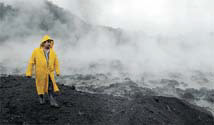
The
highway to Lago Agrio is cut off several places.
©
El Comercio
Yesterday was the worst day so far for road-construction workers
and the workers that
guard the oil-pipeline which go alongside the highway from Quito
to Lago Agrio.
Several groups of workers are isolated, where the mudflows have
broken up the road more places. Reports says that adense layer of
steam and gases covered all the area. From about
11:00 o'clock local time yesterday, the new ash rain appeared and
a strong scent to rotten egg (sulfhur gas) invaded the atmosphere.
From the highway also a new explosion in the crater
of the volcano could be observed,
that is eight kilometers to the northwest of de Piedra Fina. Stones
of up to one ton of weight interrupt the passage of the vehicles.
"Everything what we have made in these last 10 days has been
destroyed ", said one of the workers. Stones up to one ton
on the road make things difficult, and the repair work is interupted
by new mudflows all the time. At present, the workers expect
the repair now will last for at least another 6 months.
©
El Comercio
November
16th, 2002

© El Comercio
A 1 000 people remained for 20 hours without
food while the Rio Montana blocked the route between El Chaco and
Lago Agrio. Transit on this route has been restricted to 8 hours:
from
08:00 to 16:00. After the river cut the road the
repair began immediately, but the 60 workers
had to give up soon fearing new lahars to come. Yesterday, November
15th, the work started again and with the help of good equipment
they could remove more than 10 m³ of stone, ash and mud. They
are also working on the bridge that was destroyed early during the
ongoing eruption.
Twelve machines excavated a ditch of four meters
of depth, in the middle of a dust cloud filled
with a sulphur scent. Meanwhile, drivers on the route spent the
night in their vehicles, others returned to Baeza.
On
November 15 (Fri), the Government of Japan decided to extend emergency
aid in kind (portable water tanks, electric generators, water purifiers,
etc.), worth approximately
12.9 million yen, to the Government of the Republic of Ecuador,
which sustained large-scale damage from volcanic eruptions.
The eruptions have continued with several lava flows that destroyed
houses, bridges and roads mainly in Sucumbios, Pichincha and Napo
provinces in the northeastern part of the country, and about 43,000
persons have been afflicted. Approximately 100,000 hectares of farmland
has also sustained damage from the eruptions, including ash falls,
raising fears of a serious effect on agriculture and stock farming,
which is one of the principal industries of the country.
The
ash falls and other effects of the eruptions paralyzed the functions
of the capital city Quito in Pichincha province for a time, with
the international airport closed and all activities in the city
at a standstill. The Government of Ecuador has declared a state
of emergency in those three provinces.
During the dawn mud flows appeared that covered the Quito-Lago Agrio
highway again.
A seismic station has been installed, thanks to the cooperation
of the Mexican government,
to the Transecuatoriano Pipe line to provide the helicopter, logistic
and the line of microwave
so that the signal also arrives at our base and at the Provincial
Council of Pichincha that
provided a vehicle so that the technicians move to the sector.
November
14th, 2002
On Monday afternoon, the 12th,the personnel
of the Geophysical Institute and the Transecuatoriano Pipe Lline
reported columns of steam and ash that rose to a height between
6 and 7 km drifting westward. The volume of ash emission was moderate.
No ashfall was
reported from the larger cities, but locally a lot of noises were
heard during the night.
Reports from Cayambe indicated that in afternoon
and early morning a scent of sulphur
surrounded the town, but later it soon dispersed with winds. Quito,
the capital, also has had a
lot of sulphur in the air lately, which has given several people
there difficulties.
Yesterday morning, the 13th, the volcano remained
steady, and strong rains in the sector were reported. This increase
the risk for lahars.

This
figure shows the total number of earthquakes registered in the volcano
from November 1st.
Total hybrid, long period - tectonic and volcanic earthquakes are
included. The most numerous
events in the beginning where from the main eruption, later they
reflects the movement of
viscous fluids, such as magma, gases and water, inside small cracks.
November 11th,
2002
Late saturday increased activity was reported. The tremor has
been constant, maintaining its
intensity for two days. Noises and incandescence were reported from
from de Piedras Finas sector, in the Southeastern flank of the crater
of the Reventador. In addition, the constant rain at night of yesterday
developed mud flows that caused the closing of the Chaco- highway.
Until this noon (Nov.10th), explosions have not been registered.
Nevertheless, the guardian of the SOTE informed that from the town
of Reventador constant ash emissions were observed and that in the
skirts of the cone of the volcano could be seen fires in the vegetation.
The ash emitted during the morning is restricted to the Eastern
flank of the mountain range.
November 7th, 2002
According to the Washington VAAC, the first eruption on 3 November
produced an ash cloud that reached a height of ~16.8 km a.s.l. Subsequent
explosions generated more ash clouds and satellite imagery showed
discrete ash clouds on the 5th; a thin area of ash at ~16.8 km a.s.l.
was located over S Colombia and N Brazil moving E, and a thicker
ash cloud drifted W over the Pacific Ocean towards the Galapagos
Islands at a height of ~10.7 km. In addition, a nearly stationary
area of ash was observed over the Pacific Ocean off the coast of
Ecuador at a
height of ~9.1 km a.s.l. Reports today indicate that ash has come
as far south as to Peru.
A minor ash-emission occured at 06:30 AM local time today, and the
ash-cloud is drifting towards the capital of Ecuador. However, it
is still not known if it will affect the already ash-loaded city..
November
6th, 2002
According to reports received to day, activity is now decreasing.
Little ash-emissions are reported and it seems that the 2 millions
tons of ash over Quito is all they get for now. Rain in the area
washes off the ash on ground, and cattle now can eat the gras again,
but farmers are afraid that deceases amongst the cattle will still
be a problem. Tomato and orange-farm are so loaded with ash that
the farmers have to count with this a a total loss.

To
help you find out where is what. The volcanoes Cotopaxi
and Guagua Pichincha
are covered elsewhere on our site.
Map composed of different other maps found at
http://www.ecuaventura.com/
They are copyright, but we are working for a license.
November 5th, 2002
updated at 14.30 GMT
Since 1.00 o'clock local time (6:00 GMT) the volcano has been very
quiet. At that time a small emission occured with only little ash.
This is the first sign that the fever of the volcan is
decreasing, but yet it is still an active volcan.
The Civil-defense informed that ash now begins to affect the cantons
El Carmen and Pedernales, even the county of Cojimies in the Pacific
province of Manabi. The Police has supended all trafic for several
hours on the road from Santo Dominge to Quito.
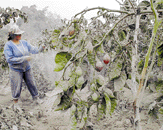
The
farmers in the area has problems....
1.
million tons of ash has come out so far.
© hoy online
During the last 24 hours the eruptive activity of the volcano the
Reventador continues the same
way as the previous day, although the periods of high activity alternate
with with periods of smaller intensity. This process is characterized
by permanent ash emissions and continuous explosions (detected by
the inhabitants of the region like permanent detonations). The emissions
of the volcano feed a column of ash that moves towards the west, covering
the area between Cayambe volcano to the north and Tungurahua volcano
to the south, and from the coast from Pedernales in the north down
to the peninsula of Santa Helena in the south. There are reports of
ash falls between the city of Cayambe in the north and the city of
Ambato in the south. Towards the west reports of ash falls come from
the province of Manabí and part of the Esmeraldas province.
The incandescent materials produced by the explosions of yesterday,
descended in form from ardent clouds or piroclásticos flows
in the canyons between Marquer and Montana..
El Instituto Geofísico reports that the eruption
from El Reventador is the largest in Ecuador
for 84 years. It has now been classified as VEI
3 on a scale from 1 til 7. The eruption from
Guagua Pichincha in 1999 was a VEI
2, and Tungurahua in the
same year, only VEI 1.
Both those eruptions are well documented on their own pages here.
However, as we are
still working without getting paid for this service, we have no english
translation
available, but the pictures tell their story without words.
|
To keep our pages free for commercials,
please contribute if you'd like us to be here tomorrow!
Give us your e-mail address and we will mail news about our
pages regularly.
|
According to scientists, everybody were taken by
surprise this time. So far they have figured
out that the next move from Reventador might be one of three possibilities:
Either one very
strong explosion, or a duration of 3 to 4 months like now, or a decreasing
activity, but with a duration of more than 6 months, like the one
from Tungurahua since 1999.
Since eruption began there have been three large eruptions,
and each time the mushroomlike
ash- and gas-column has rised to some 10.000 - 15.000 m asl.. When
Guagua Pichincha and Tungurahua erupted in 1999, they showed signs
of activity several months before the eruptions, Reventador only gave
5 hours warning this time
The eruptions from Reventador are of the vulcaneana
type, strong powerful eruptions with
a lot of energy inside, but of very short duration. The thickness
of falling ash over Quito is now
up to 5 cm thick, but was only 1 cm when Guagua Pichincha erupted
in 1999.
Rain now helps cleaning the city of Quito. Several
volutary organizations and fireworkers etc
now try to coordinate the work to get the situation under control.
Not all people followed the instructions yesterday. One order was
to limit the speed of vehicles to 20 km/hour, to prevent
ash blew up and circulate all over. Not many followed that advise.
In some parts of the capital, i.e. in Solanda, there
were no more electricity on monday..
In the valleys around Quito no more freshwater was available..

Not
much left over after a pyroclastic flow has passed the farm here in
Sucumbíos.
©
Photo: MARTIN BERNETTI/AFP - ElComercio
November 4th, 2002
afternoon updates:
14:36 GMT: The eruption of theReventador volcano (100 kilometers
northeast of the city of Quito) has not caused victims until this
moment. However, for those who live in the
neighborhoods of the mountain, the situation carries problems, mainly
in form of material losses.
The reason of this is that great amount of cattle heads
is isolated in slopes of the mountain,
due to the flows of mud and lava that have destroyed the access roads
to the zone.
Before this, the Civil defense works to evacuate the animals and to
avoid that their
owners try out various dangerous rescue actions.

Municipal authorities assure normal supplying potable
water
The mayor of Quito, Paco Moncayo, affirmed in declarations to the press
that the citizenship does not have to worry, at the moment, of the normal
potable water supply. In case that the situation gets worse, the Company
Metropolitana de Potable Agua and Sewage system,
count on plans to face the situation.
The International Airport Mariscal Sucre continues
closed. The aeronautical authorities of the country maintain the order
that the operations of the airport of Quito continue closed,
until the ash rain finishes and allows the entrance from aircrafts to
the tracks.
Meanwhile, the internal flights from and towards the
city of Quito and the international flights will continue being transferred
to other cities of the country, specially Guayaquil.
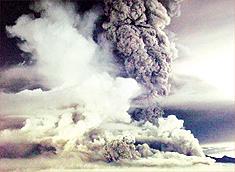
© La Hora, Quito
The volcano also expelled pyroclastic
flows, that are incandescent ash clouds, volcanic rocks
and gases, that reach temperatures between 500 and 700 degrees Celsius.
This material
lowered by slopes of the volcano at a speed of 200 kilometers per hour.
The flows arrived
the road from Baeza to Lago Agrio, which is now closed for any traffic.
The effects in the neighborhoods of the zone are on
material, not on humans, because the pyroclastic flows became mudflows
and destroyed machinery of companies that operate in different projects,
including the pipe lines transsection (SOTE) and the one of heavy crude.
(OCP). Two houses in the vicinity of the Reventador caught fire, two
people were wounded,
and taken care of in the Baeza hospital.

Quito,
sunday afternoon, local time
© Ecuador-Travel.net
Reventador erupted early sunday morning local time, and sent up smoke
and hot ash about
15.000 m asl. This forced the International Airport in Quito to close
immidiately. Monday
the schools in the area are ordered to be closed. Further, the Baeza-Lago
Agrio hightway
nearby was hit by burning ashclouds and a lava-flow, and the Trans-Ecuadorian
oil pipeline
was also threatened. No injuries so far, which probably is due to the
early evacuation of some 1.000 inhabitants from two nearby villages,
San Rafael and Manuel Galindo
From the morning of the nightmare for the people who live in the skirts
of Reventador volcano began yesterday. The bad memories of the eruption
of this colossus in 1976 were updated
when, around the 07:00, the volcano began to throw volcanic material
that lowered by the
natural courses of the rivers Marker and Montana, evaporating them and
erasing them
of the map, to end at the Quijos river; but before, lava destroyed the
bridge at las
Tres Cruces
and broke up that unites Chaco with the parish Reventador,
on the route that leads to Nueva Loja (Lago Agrio).

Veien
fra Quito - Lago Agrio ble avbrutt i området ved las Tres Cruces
av lahar.
Flommene nådde ned til Río Quijos.
© Infografía/El Comercio
A dense ash layer covered most with the populations of Napo and Sucumbíos,
which produced several hours of the dark. This ash cloud went to Nueva
Loja and the northwest, especially to Cayambe and Quito. The Civil defense
of Napo informed that around 800 people who live in
small villages and surrounding populations to the volcano they were
evacuated and sheltered
in the Chaco; however, two people has disappeared, which has not been
confirmed.
It is estimated that 3 000 inhabitants of the parishes Manuel Galindo
and San Francisco are affected. The settlers have begun to evacuate
from the morning. There are two wounded
and three destroyed houses.
The few passers-by who then walked by the streets of
the capital on sunday, showed surprised, cleaned their faces, covered
their faces and protected the children. For the transport of taxis the
ash fall was beneficial, received its races to the price that seemed
to them.
Many did not take precautions. The Red Cross, the Direction of Metropolitan
Security and the Geophysical Institute recommended that to leave house
the respiratory routes with a mask or handkerchief were protected, and
glasses for their eyes were used.
It is necessary to cover the water tanks. It is necessary to avoid that
the culverts are covered, cleaning the volcanic ash without using water.

photo by P. Chevalier
©
In that sector, whose agricultural production is of
African palm, maize, rice, yucca, sugarcanes
and oranges, live species of animals which include the tapir, the agouti
or guatuza, jaguar
and tigrillo
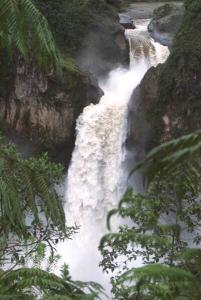
San
Rafael Waterfall, Rio Reventador
©
Jungle Photos Amazon 2002
|
Latest news always above. Below
for history.
|
xx.03.1974
The volcano El Reventador is a 1,500-m-high composite cone that is growing
in the caldera
of the older El Reventador. After many years of only
fumarolic activity, major flows of lava occurred in June-August
1972 that had a volume of approximately six million cubic meters.
The volcano remained relatively inactive until November 1973 when a
smaller flow left that
crater and traveled on e and one-half kilometers to the southeast. Numerous
laharic flows
related to this activity have carried boulders up to five meters in
length up to three kilometers
from the cone.
Six days (23-28 February 1974) were recently spent on the
volcano studyng the present activity. The blocky lava flow of November
1973 has backed off the flanks and remains still active
halfway up the cone. The explosive nature of the volcano has increased
dramatically.
When visibility permitted, explosive activity was recorded every 20-30
minutes. It was accompanied by loud explosions that, at times, shook
our campsite 3 km distant, by red
flashes from the crater, by gray-brown eruption clouds that rose a
kilometer above the crater,
and by incandescent red ejecta (often blocks
up to 5 m in diameter) that rolled down the
sides of the cone. This explosive activity was not observed in December
1973 and marks an important change in the nature of the activity.
Inaccessibility and poor weather condition
preclude frequent monitoring of this volcano.
xx.01.1976
An explosive eruption began during the early morning of 4 January.
At dawn an ash column
1 km high was observed. Fine ash was carried W and SW over the Andes,
dusting Quito
through 10 January. Bombs blown 100 m vertically from the crater were
large enough
to be seen by the naked eye from a distance of 3 km. Strange seismic
signatures,
detected 90 km away (at Quito) and attributed to Reventador, began
at 0115 on 4 January
and continued until 0900 on 9 January. A portable seismograph 10 km
from the cone
measured continuous harmonic tremor.
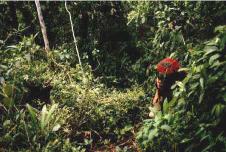
The
highway up to the volcano....
http://www.ecuador-travel.net/tour.trekking.T5.htm
Two lava flows descended from the breached crater and divided
into three lobes at the
base of the cone. During the first 40 hours flows traveled approximately
1.5 km E at 37 m/hour. By 9 January the three lobes had traveled 2.5
km and were advancing approximately 5 m/hour over lahar deposits and
jungle. As of 27 January the lava flows had stopped, but infrequent
explosive activity, including nuées ardentes, was continuing. The
continual ash column had terminated by 25 January. The flows were
a black basaltic andesite with olivine, augite, hypersthene, and oxyhornblende.
*************
Reventador is the most frequently active of a chain of Ecuadorian
volcanoes in the
Cordillera Real, well east of the principal volcanic axis. It is a
forested stratovolcano
that
rises above the remote jungles of the western Amazon basin. A 3-km-wide
caldera breached
to the east was formed by edifice collapse and is partially filled
by a young, unvegetated stratovolcano that rises about 1300 m above
the caldera floor. Reventador has been the source
of numerous lava flows as well as explosive eruptions that were visible
from Quito in historical
time. Frequent lahars in
this region of heavy rainfall have constructed a debris plain on the
eastern floor of the caldera.
(Global Volcanism Program )
| |
Linker:
|
|
|
Azultours:
Trekking Trip to El Reventador, english |
|
|
|
Search this site - Søk våre sider
|
